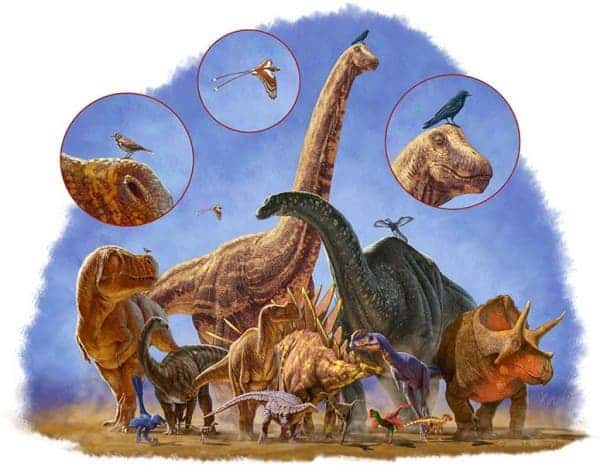
Some 65 million years ago an asteroid impact caused countless species of land, marine and plant life to become extinct, including the mighty dinosaur which dominated the planet for millions of years. Not all species of the dinosaur group vanished, however. You’ve guess right: birds! Now, a new study sheds light on why birds were able to survive – they shrunk in size well before the apocalypse hit.
Movies like Jurassic Park cause people to imagine dinosaurs as huge and scary reptile-like beings, which is true in a way, but not quite. Dinosaurs comprise an extremely diverse groups of animals and some 230 million years ago, the largest dinosaur didn’t weigh more than 35 kilograms, most being the size of a modern day dog. Within just a couple million years, however, a niche explosion caused dinosaur species to diversify and grow ever bigger until they reached startling heights, like the case of the mighty Argentinosaurus, which stretched some 35 meters from nose to tail, weighed in at a staggering 90,000 kilograms.
One group of dinosaurs, however, became content to only grow in diversity of species and not in size like the rest of the other dinosaurs – the maniraptorans, feathered dinos that also include the famous Velociraptor from the aforementioned Jurassic Park. A group of researchers at Oxford University estimated the body size of 426 different species of dinosaurs, using the thickness of their fossilized hind leg bones as a proxy for their overall weight.
The findings are nothing short of remarkable. While dinosaurs, across all groups, expanded both in size and diversity of species, at some point that trend slowed down fairly quickly. Dinosaurs stopped growing (thank goodness!) and sported a constant body size and weight, with one exception. Maniraptorans, apparently, continued to evolve bigger and smaller species as they expanded into an ever wider variety of ecological niches over a period of 170 million years.
When a huge rock from outer space collided with our planet some 65 million years ago, only feathered maniraptorans which were small enough to cope and adapt with the changing conditions were able to survive out of all the dinosaurs. These feathered dinosaurs, which didn’t weight more than a 1 kg, were none other than the birds we all know today. Presently, there are some 10,000 species of these feathered fliers, making them the most diverse of all the four-limbed animals.
So, basically because the rest of the other dinosaurs were too fat for their own good, only the maniraptorans were capable of surviving and adapting in those hellish conditions, all because they started diversifying and, most importantly, didn’t neglect growing light bodies long before the asteroid came. Don’t put all your eggs in one basket, says the dinosaurs.
Findings appeared in PLOS Biology.
Was this helpful?



